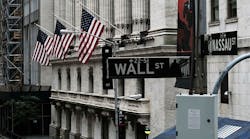The U.S. economy expanded in the second quarter at a slightly faster pace than previously estimated on revisions to imports and software spending, bolstering the strongest period of growth since 2014, according to Commerce Department data released Wednesday.
Highlights of Second-Quarter GDP (Second Estimate)
- Gross domestic product grew at a 4.2% annualized rate (est. 4%), revised from 4.1%; still fastest since third quarter of 2014.
- Consumer spending, the biggest part of the economy, grew 3.8% (est. 3.9%), revised from 4%; reflects downward revisions in motor vehicles, nondurable goods, health care.
- Intellectual-property investment rose at 11% pace, revised from 8.2%; imports fell 0.4%, boosting GDP calculation, after previously reported 0.5% rise, reflecting petroleum.
- Corporate pretax profits rose 7.7% year over year and 3.3% quarter over quarter, both the most since 2014, in the first estimate issued for last quarter; follows 5.9% y/y rise in first quarter and marks seventh straight y/y gain
Key Takeaways
The revisions to GDP, the value of all goods and services produced in the U.S., offer President Donald Trump another chance to stake his claim to the pickup in growth, as he did following the initial GDP report a month earlier. Trump had called the numbers “amazing” and “very sustainable,” declaring his policies, including the biggest tax overhaul since the Reagan era, a success.
Even so, the pace of expansion is expected to cool from the second quarter as the tax-cut boost fades, a trade war threatens business demand and the Federal Reserve raises interest rates further. Economists surveyed by Bloomberg project a 2.9% expansion for the full year.
Household purchases, which account for about 70% of the economy, have been supported by a strong job market and lower taxes. In addition, a rise in gasoline costs earlier this year has eased, reducing a risk to spending.
The continuing acceleration in profit growth suggests corporate America is benefiting from strength in consumer and business demand. That, together with lower taxes, could bode well for further gains in investment this year.
Price data in the GDP report showed inflation was in line with the Fed’s 2% goal. Excluding food and energy, the central bank’s preferred price index that’s tied to personal spending rose at a 2% annualized rate, the same as in the initial report.
Other Details
- Net exports added 1.17 percentage point to GDP growth, revised from a 1.06-point boost; inventories subtracted 0.97 point, compared with the previously reported 1-point drag.
- Gross domestic income, adjusted for inflation, advanced 1.8% following 3.9% gain.
- Nonresidential fixed investment -- which includes spending on equipment, structures and intellectual property -- increased 8.5%, revised from 7.3%; spending on business equipment rose 4.4%, revised from 3.9%.
- Residential investment fell at a 1.6% rate, revised from a 1.1% decline.
- Final sales to domestic purchasers, which strip out trade and inventories -- the two most volatile components of the GDP calculation -- advanced at 3.9% rate, same as initial reading.
- Government spending increased at a 2.3% rate, revised from 2.1%; the figures reflected higher spending on defense and by state and local governments; defense spending rose by most since 2009.
- Real disposable personal income rose at 2.5% pace, revised from 2.6% gain.
GDP report is the second of three estimates for the quarter.
By Jeff Kearns



